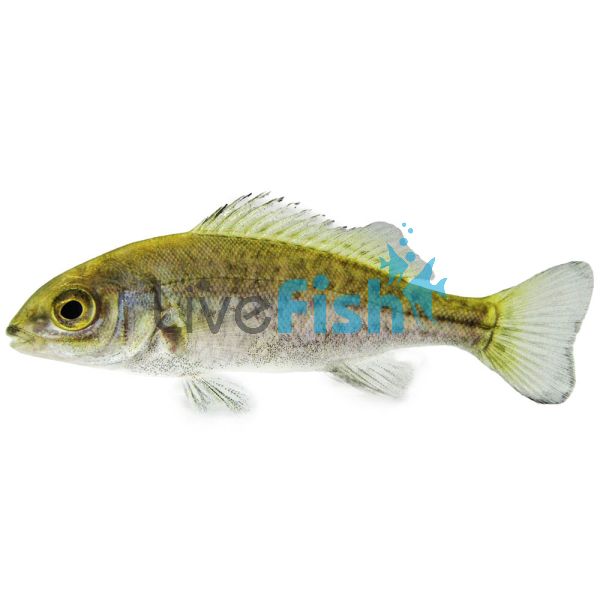Silver Perch 12cm
Silver Perch are a native Australian fish that are easy to breed, easy to feed and easy to maintain. Silver Perch are an ideal species to start with if you are new to aquaponics.
Silver Perch
This native Australian freshwater fish is a popular option for aquaponic systems and has a high tolerance for poor water quality.
They grow to medium size (30–50 cm), and they tend to prefer the cooler water temperatures (15°- 25°C) that an aquaponics system provides.
These large grunters have a small head and eyes, and a small mouth in relation to their bodies. They have a medium-height spiny dorsal fin, angular dorsal and anal fins, and a forked tail. This species is laterally compressed and streamlined. Large individuals will grow a large hump behind the head and a very deep body. They are a dark grey to silver or grey-brown colour on the back, and silver-grey on the sides, with darker scale margins forming a checkered pattern. Silver Perch have an off-white belly and also has white pelvic fins with dark caudal and dorsal fins.
The natural range of this fish in the wild encompasses the western drainage of New South Wales, including the majority of the Murray-Darling Basin.
The Silver Perch's natural habitat is varied covering the cooler waters of the upper highlands, to the lower slower flowing rivers in the west. It is naturally an omnivore and will feed on insects, crustaceans, and vegetation. Silver perch can reach weights of up to around 13 lbs or 6kg, but individuals weighing more than 3kg are uncommon. Natural populations have declined dramatically as a result of habitat degradation and fishing pressure.
This species will spawn in reaction to natural environmental changes, most notably an increase in the water level as a result of heavy rain especially when combined with an increase in the water temperature to over 23° C. Females can lay up to 160,000 eggs, and this hatch 36 hours later. For around the first 5 days, the fry will survive on the yolk sacs they hatch with, and then they will begin feeding on zooplankton.
Although the silver perch was identified as a suitable candidate for aquaculture in the early 1900s, it wasn't until 1965 that in-depth studies were undertaken on this species.
Since then, there has been a focus on the production of silver perch and other native species in hatcheries.
Growth and conditions
Fingerlings are weaned on a commercial diet meaning that you can feed them pellet food right away. The ideal temperature range is 23-28° C for growing your fish. Silver perch will grow to a harvest size of 600-800g in about 18 months in the right environment.
Silver perch may accept low protein diets made up of plant and meat meal proteins. The majority of available feeds have a protein concentration of roughly 35%. Pellets are available in both floating and sinking forms.
Water exchanges may be required in large systems from time to time.
Characteristics and Behaviour
The Silver perch has several biological properties that make it ideal for aquaponics systems. These include its ability to be raised in high densities, general hardiness, and high survival, rapid and uniform growth, willingness to accept pellet food. It is also non-cannibalistic, has a high meat content, excellent eating qualities, and will accept a wide variety of natural foods in addition to pellet food.
During the fingerling stage, silver perch have a wide range of sizes.
Water quality
Silver perch are freshwater fish. They are, nevertheless, exceedingly resilient and can withstand a wide range of water quality factors. Water quality in intensive ponds can be unpredictable at times, and fast fluctuations might make the difference between healthy fish and high mortalities.
We recommend that you should start with lower stocking densities and then you can increase your stock levels as you gain experience. Dissolved oxygen levels should be kept above 3mg/L and free ammonia levels should be kept below 0.1mg/L.
Poor water quality can reduce growth rates and increase vulnerability to disease agent infection.
Water quality should be monitored on a frequent basis to help keep it at an appropriate level.
To maintain optimal water quality, you can modify aeration, water exchange, feedings, and stock numbers.
Diseases and parasites that can affect Silver Perch in your Aquaponics System
Infection with illness and parasites is a reaction of fish to environmental pressures. The most common are degradation of water quality and overcrowding. The majority of diseases and parasites are found in ponds and other natural aquatic habitats. However, as fish get stressed, the possibility for the illness to infect rises due to a decrease in the fish's immune mechanisms. Handling, poor water quality, congestion, predation, and inadequate diet are all stressors.
| Scientific Name | Bidyanus bidyanus |
|---|




